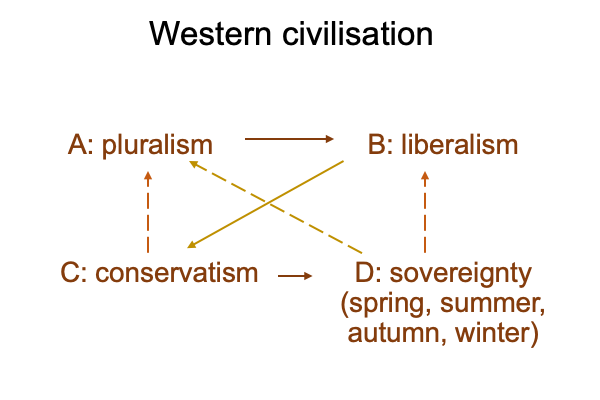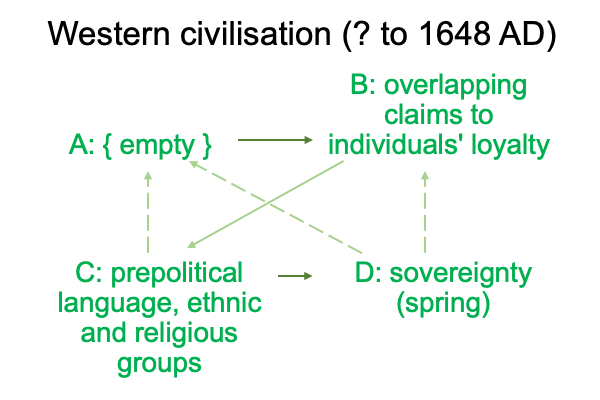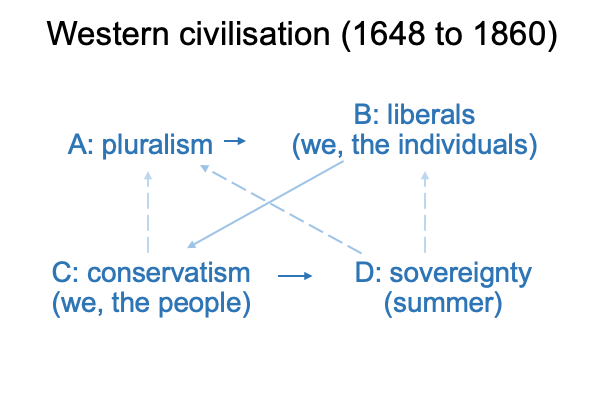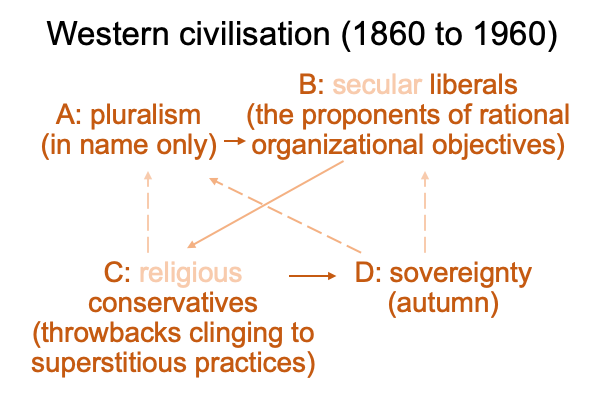0083 Here is Diesen’s view of Western civilisation, since the time of who? Machiavelli? Martin Luther? Thomas Hobbes?

0084 For each of these figures, Western civilization, often called “Christendom”, is already old. The longest living institutions are ethnic and religious. Both contribute to the sovereignty of the nation-state, along with a wide range of other loyalties. Loyalties extend to the church, the king, the barons, the trade guilds and other political actors. The word, “religion”, is used to describe competing Christian (but also political) factions. The (so-called) thirty years war resolves the contested loyalties with the Peace of Westphalia (1648 AD).
The Peace of Westphalia concludes the spring of sovereignty (D) with a treaty elevating the king as sovereign within each jurisdiction. Plus, jurisdictions are primarily territories of common ethnic, religious and linguistic traditions.
0085 Here is the spring of sovereignty for the West.

0086 The summer starts with the so-called “Western Enlightenment”. Pluralism enters the picture as the balance between liberals (we, the individuals) and conservatives (we, the people). The summer of pluralism peaks during the time of the French and American Revolutions. After that, the West rushes into the mechanical revolution, which empowers individuals and disempowers the people.
Individuals gain sovereignty. Liberals insist on the rights of the individual. Rights are often enumerated in constitutions. Constitutions exemplify gesellschaft. Prepolitical ethnic religiosity erodes. The term, “secular”, as a way to label irreligious liberals, appears in the English lexicon around 1860, at the end of the summer of sovereignty.

0087 In Western Europe, autumn begins with the consolidation of Germany and Italy, as well as the rise of divisive political movements (including Marxism). In America, autumn opens with the War of Southern Rebellion and the War of Northern Aggression. The war is anything but civil, which is the label that gets attached to the conflict, fifty years later. With this precedent, I re-label the First and Second World Wars as the First and Second Battles of the Enlightenment Gods, the Unexpected War Among Naive Mercantilists (Who Should Have Known Better) and The Hot War Among Fraternal Ideologies.
The natural and social sciences advance. Educated secular liberals propose rational organizational objectives that demand sovereign power in order to implement. Religious conservatives are more and more regarded as throwbacks to the superstitious attitudes of pre-scientific ages.
When Pope Leo XIII issues an encyclical decrying the errors of modernism, secular know-it-alls laugh. Science demonstrates that ancient and Aristotelian explanations of the world do not withstand scientific scrutiny. Fare thee well, Saint Thomas Aquinas. It is too bad that you are no longer relevant.
Pluralism operates in name only, because both liberal and conservative elites share a common conviction that a centralizing government is the only authority capable of pursuing rational organizational objectives, such as urban planning (getting rid of ethnic Catholic neighborhoods in urban cities in USA’s “North”) and value-free education(replacing an apparently irrational Bible with principles that every rational agent would agree with). The revisionist historian, Dr. E. Michael Jones, writes book after book on these topics. All are entertaining. All describe how both liberal and (so-called) conservative elites operate against religious folk, of all stripes, during these times.
0088 Here is a diagram for autumn.

0089 In chapter four, Diesen discusses the winter. He calls it, “the graveyard” of sovereignty.
